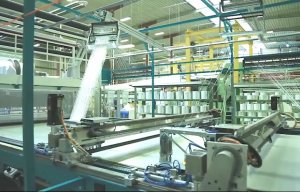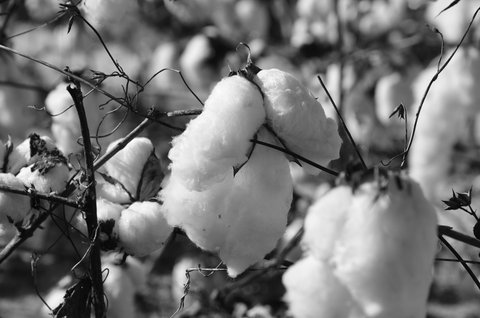
Metyx USA boosts technical textiles production capacity
According to Bruce Atherley, Executive Director of CCI, consumers are becoming more aware of how everyday choices impact the world around them.

17th May 2018
Innovation in Textiles
|
Washington, DC
 According to Bruce Atherley, Executive Director of Cotton Council International (CCI), consumers are becoming more aware of how everyday choices impact the world around them. Man-made materials we use every day, such as plastics, are having a detrimental impact on the planet, though what many consumers may not realise is that making responsible choices when it comes to the clothing and textiles they choose can make a huge difference.
According to Bruce Atherley, Executive Director of Cotton Council International (CCI), consumers are becoming more aware of how everyday choices impact the world around them. Man-made materials we use every day, such as plastics, are having a detrimental impact on the planet, though what many consumers may not realise is that making responsible choices when it comes to the clothing and textiles they choose can make a huge difference.
CCI is a non-profit trade association that promotes US cotton fibre and manufactured cotton products around the globe with its COTTON USA mark. Its reach extends to more than 50 countries through 20 offices around the world. With more than 60 years of experience, CCI’s mission is to make US cotton the preferred fibre for mills/manufacturers, brands/retailers and consumers, commanding a value-added premium that delivers profitability across the US cotton industry and drives export growth of fibre, yarn and other cotton products.
Bruce Atherley is a senior executive with a record of success in general management and marketing roles, who has done business in over twenty countries. As an Executive Director of Cotton Council International, Bruce is responsible for the international promotion of US cotton and cotton products in order to drive exports.
Growing demand for natural fibres
“Disposable, fast fashion has made a big contribution to the rise of synthetic, man-made fibres that are cheap to manufacture, though not easily recycled – leaving a damaging footprint on the environment. Unfortunately, scientific research also suggests that clothes made from synthetic fibres, such as polyester and acrylic, may damage the environment throughout their usage, by releasing hundreds of thousands of tiny synthetic particles in every wash,” said Bruce Atherley.
“The good news is that an increased level of awareness of this unsustainable product lifecycle has created a desire among brands, retailers and consumers to return to higher quality garments that are less damaging and retain their value for longer.”
“This is just one of the reasons why we are seeing global demand for natural fibres, such as US cotton, that decision makers know they can trust. While cotton has long been understood as a high-quality, reliable fibre, this is particularly true for US cotton, which doesn’t have the same quality and pest issues as other major cotton producing countries.”
“In fact, US cotton exports are estimated to reach 15 million bales in the 2017/18 marketing year, which is greater than the February US Department of Agriculture (USDA) estimate of 14.5 million bales. US cotton export sales have also been very strong with early sales surpassing recent crop years.”
How is the US cotton industry playing its part?
“The strong performance of US cotton is supported by the industry proactively adopting and implementing sourcing practices that put quality and responsibility at the heart of development,” Bruce continued.
“In 2017, the entire US cotton industry approved industry policy and established a COTTON USA Sustainability Task Force with the purpose of setting national goals for measurable continual improvements in key areas of environmental stewardship, farm productivity and resource efficiency such as land, water, air, input and energy use.”
“Membership in the Task Force represents all of the US cotton industry’s seven segments: cotton producers, ginners, merchants, Co-ops, warehouses, cottonseed processors and US textile mills. This holistic approach helps to ensure a coordinated and effective response to environmental issues.”
“The US cotton industry is setting goals that are aimed at building on the strong environmental gains its producers already successfully achieved over the past 30 years. These goals are benchmarks set to continue that trend and to reinvigorate efforts through the setting of realistic targeted reductions.”
“The specific goals to be achieved by 2025 are: reducing the amount of land needed to produce a pound of cotton fibre by 13%; reducing soil loss by 50%, in balance with new soil formation; increasing water use efficiency (more fibre per gallon) by 18%; reducing greenhouse gas emissions by 39%; increasing soil carbon in fields by 30%; and reducing energy to produce seed cotton and ginned lint by 15%.”
“In addition, the US cotton industry is using science-based metrics developed by Field to Market: The Alliance for Sustainable Agriculture to assess environmental impacts and identify opportunities for improvement. Field to Market works across the entire agricultural supply chain to define, measure and advance the sustainability of US crop production.”
Why is innovation key for a brighter future?
“If we are to successfully move away from our reliance on man-made fibres, then innovation will be key. A continued focus on innovation will inspire everyone in the textiles business to think about the many opportunities that natural fibres such as US cotton can offer,” Bruce explained.
“Research commissioned by Cotton Incorporated in the US, UK, India, Germany, Italy, Mexico and China in May 2017 shows that consumers responded favourably to the idea that cotton could wick moisture better than synthetics. Some 61% of participants said that ‘new and innovative cotton products can now be made to evaporate sweat more quickly, making them a superior choice in athletic wear’.”
“This clearly shows that consumers are ready and willing to hear new ideas in technology, fashion and blends. At COTTON USA, we encourage this through our What’s New in Cotton initiative, which is designed to introduce a collection of US cotton-rich products that demonstrate both the strengths of US cotton, such as comfort, softness and durability, with new performance characteristics not usually associated with cotton.”
“Our intent is to inspire ideas and inspiration with brands, so they will want to invent new fabrics with natural fibres, including US cotton. By continuing to educate, connect and inform everyone in the supply chain about the potential of natural fibres, we can help to build a more environmentally friendly and sustainable industry.”

Business intelligence for the fibre, textiles and apparel industries: technologies, innovations, markets, investments, trade policy, sourcing, strategy...
Find out more